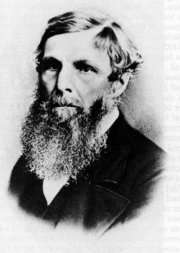William Froude
William Froude (/ˈfruːd/;[1] 28 November 1810 in Devon[2] – 4 May 1879 in Simonstown, South Africa) was an English engineer, hydrodynamicist and naval architect. He was the first to formulate reliable laws for the resistance that water offers to ships (such as the hull speed equation) and for predicting their stability.
William Froude | |
|---|---|
 William Froude | |
| Born | 28 November 1810 |
| Died | 4 May 1879 (aged 68) Simonstown, South Africa |
| Nationality | English |
| Education | Westminster School |
| Occupation | Engineer |
| Engineering career | |
| Significant advance | Hydrodynamics , Froude number |
| Awards | Royal Medal (1876) |
Biography

Froude was born at Dartington, Devon, England, the son of Robert Froude, Archdeacon of Totnes and was educated at Westminster School and Oriel College, Oxford, graduating with a first in mathematics in 1832.
His first employment was as a surveyor on the South Eastern Railway which, in 1837, led to Brunel giving him responsibility for the construction of a section of the Bristol and Exeter Railway. It was here that he developed his empirical method of setting out track transition curves and introduced an alternative design to the helicoidal skew arch bridge at Rewe and Cowley Bridge Junction, near Exeter.[3][4] During this period he lived in Cullompton and was Vicar's Warden at St Andrew's Church from 1842 to 1844. He organised, and paid a large amount to the rebuilding of the chancel and other restoration work. He also offered to pay to restore the nave if local people would pay 10% of the cost but this offer was refused. On completion of the Bristol to Exeter line in 1844 he left the town.[5]
At Brunel's invitation Froude turned his attention to the stability of ships in a seaway and his 1861 paper to the Institution of Naval Architects became influential in ship design. This led to a commission to identify the most efficient hull shape, which he was able to fulfil by reference to scale models: he established a formula (now known as the Froude number) by which the results of small-scale tests could be used to predict the behaviour of full-sized hulls. He built a sequence of 3, 6 and (shown in the picture) 12 foot scale models and used them in towing trials to establish resistance and scaling laws; Raven's sharp prow followed the "waveline" theory of John Scott Russell, but Swan's blunter profile proved to offer lower resistance. His experiments were vindicated in full-scale trials conducted by the Admiralty and as a result the first ship test tank was built, at public expense, at his home in Torquay. Here he was able to combine mathematical expertise with practical experimentation to such good effect that his methods are still followed today.[6]
In 1877, he was commissioned by the Admiralty to produce a machine capable of absorbing and measuring the power of large naval engines. He invented and built the world's first water brake dynamometer, sometimes known as the hydraulic dynamometer, which led to the formation of Heenan & Froude Ltd in Birmingham.[7]
While on holiday as an official guest of the Royal Navy he died in Simonstown, South Africa, where he was buried with full naval honours.
He was the brother of James Anthony Froude, a historian, and Hurrell Froude, writer and priest. William was married to Catherine Henrietta Elizabeth Holdsworth, daughter of the Governor of Dartmouth Castle, mercantile magnate and member of Parliament Arthur Howe Holdsworth.
Works
- On the rolling of Ships. Parker, Son and Bourn. 1862.
See also
References
- Merriam Webster Online (for brother James Anthony Froude)
- Phil Russell (18 September 1999). "Navies in Transition: William Froude". Archived from the original on 26 February 2001.
- Simmons, Jack; Biddle, Gordon (1997). "Bridges and Viaducts". The Oxford Companion to British Railway History. Oxford, England: Oxford University Press. p. 47. ISBN 0-19-211697-5.
- Brown, David K. (2006). The Way of a Ship in the Midst of the Sea: The Life and Work of William Froude. Penzance: Periscope Publishing. p. 26. ISBN 1-904381-40-5.
- Pugsley, David (1993). St. Andrews Church, Cullompton. English Life Publications. p. 11. ISBN 0851013023.
- Berry, William John. "The Influence of Mathematics on the Development of Naval Architecture". In: Proceedings of the International Congress of Mathematicians in Toronto, August 11–16. 1924. vol. 2. pp. 719–736. (discussion of Froude's research on rolling motion, pp. 724–726)
- "About Us". Froude Hoffmann. Archived from the original on 2 March 2013. Retrieved 9 January 2013.
- Brown, Derek K; Lambert, Andrew. "Froude, William (1810–1879)". Oxford Dictionary of National Biography (online ed.). Oxford University Press. doi:10.1093/ref:odnb/10204. (Subscription or UK public library membership required.)
External links
| Wikimedia Commons has media related to William Froude. |
- Works by or about William Froude at Internet Archive
- Biography of William Froude
- "Froude, William." Encyclopædia Britannica. 2007. Encyclopædia Britannica Online. 29 April 2007.
- Second Torquay honour for Naval architect William Froude. Herald Express, 26 December 2013.
- William Froude at Find a Grave